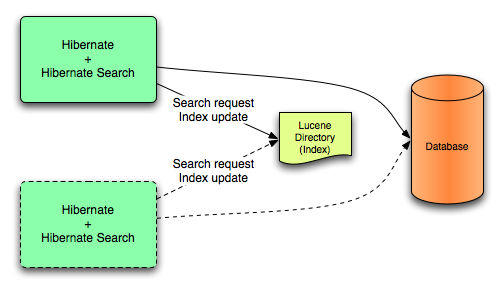2.2. Back end
Hibernate Search offers the ability to let the scoped work being processed by different back ends. Two back ends are provided out of the box for two different scenarios.
2.2.1. Back end types
2.2.1.1. Lucene
In this mode, all index update operations applied on a given node (JVM) will be executed to the Lucene directories (through the directory providers) by the same node. This mode is typically used in non clustered environment or in clustered environments where the directory store is shared.

Lucene back end configuration.
This mode targets non clustered applications, or clustered applications where the Directory is taking care of the locking strategy.
The main advantage is simplicity and immediate visibility of the changes in Lucene queries (a requirement in some applications).
2.2.1.2. JMS
All index update operations applied on a given node are sent to a JMS queue. A unique reader will then process the queue and update the master index. The master index is then replicated on a regular basis to the slave copies. This is known as the master/slaves pattern. The master is the sole responsible for updating the Lucene index. The slaves can accept read as well as write operations. However, they only process the read operation on their local index copy and delegate the update operations to the master.

JMS back end configuration.
This mode targets clustered environments where throughput is critical, and index update delays are affordable. Reliability is ensured by the JMS provider and by having the slaves working on a local copy of the index.
Note
Hibernate Search is an extensible architecture. Feel free to drop ideas for other third party back ends to
hibernate-dev@lists.jboss.org.